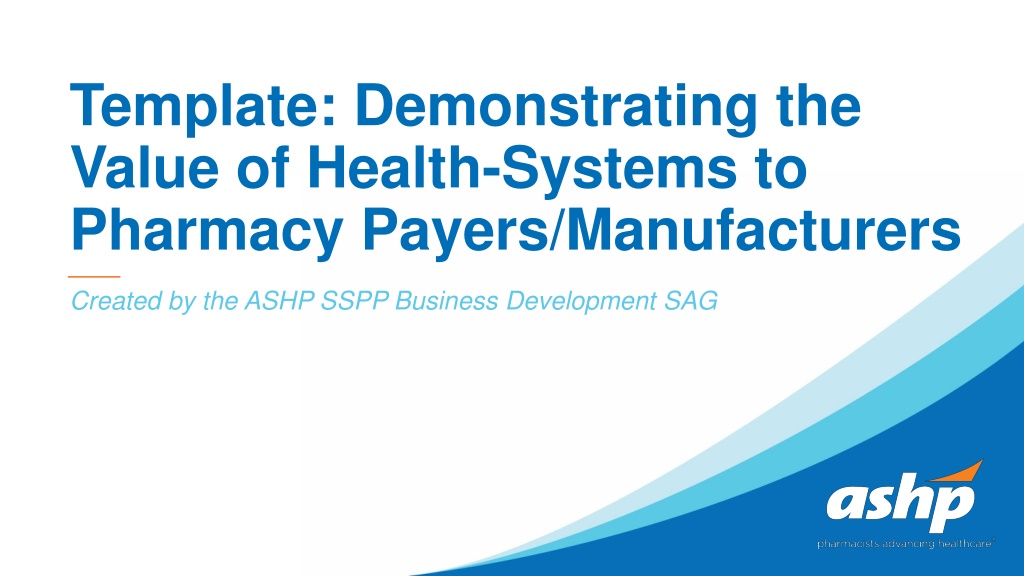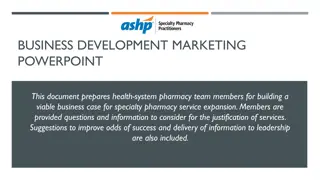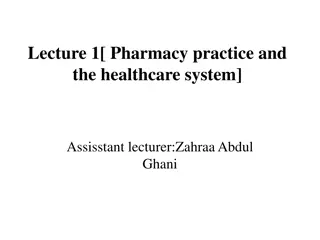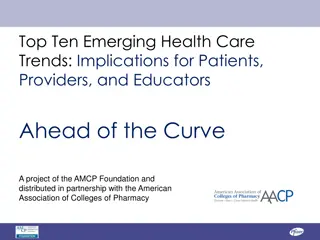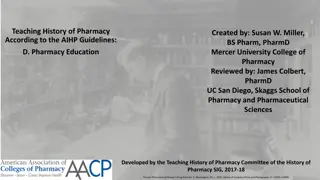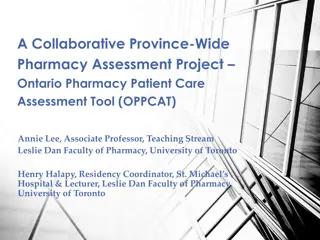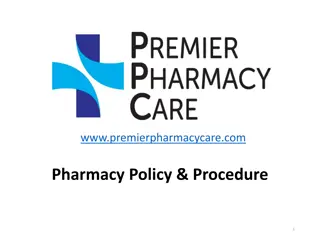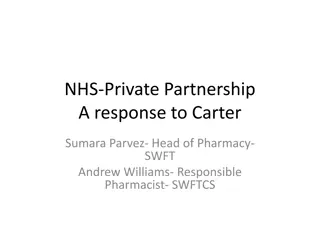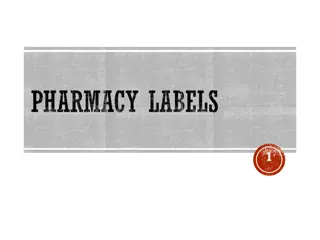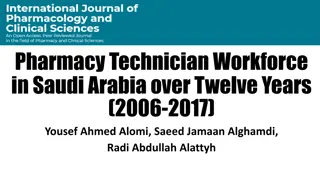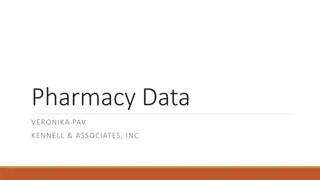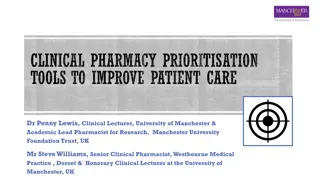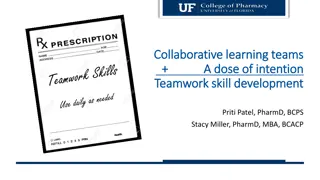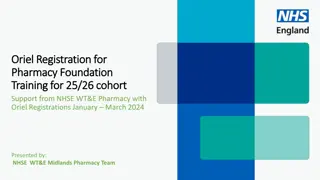Leveraging Health-System Value for Pharmacy Payers/Manufacturers
Explore the comprehensive services and specialty pharmacy offerings of a health system, highlighting community impact, patient satisfaction, and therapeutic areas covered to demonstrate value to pharmacy payers and manufacturers. Discover the potential for collaboration, shared EHR benefits, and superior patient outcomes within the health-system model.
Download Presentation

Please find below an Image/Link to download the presentation.
The content on the website is provided AS IS for your information and personal use only. It may not be sold, licensed, or shared on other websites without obtaining consent from the author. Download presentation by click this link. If you encounter any issues during the download, it is possible that the publisher has removed the file from their server.
E N D
Presentation Transcript
Template: Demonstrating the Value of Health-Systems to Pharmacy Payers/Manufacturers Created by the ASHP SSPP Business Development SAG
Introduction to Services Health-System Description of or numbers of hospitals in system, clinics, EDs, services provided Home Care, long-term care, specialties available Service area and number of patients served (or visits) Number of employees Call out to tailored area you are focusing on (REMS medication, presence of patient population presence with orphan disease, etc.) Community impact and presence in community Centers of excellence Recognitions received Notable trials Presence of key opinion leaders
Introduction to Services Specialty Pharmacy Opportunity to differentiate the benefit of your health-system specialty model vs. others Highlight Years of service to community Number of team members dedicated to specialty and related services (breakdown roles as relevant) Number of prescriptions filled, patients served, payer mix (commercial, Medicare, Medicaid) Service differentiators (same day fills, local delivery, texting, temperature resilient packaging) Patient and provider satisfaction Service model (clinic integrated vs. centralized model vs. hybrid) Collaboration with providers, clinic staff, ancillary services Support for more seamless transitions of care Benefits of shared EHR Reduction of rate-limiting steps Vested interest in patient outcomes and superior outcomes realized, as relevant (SVR12, FEV1, RAPID3, etc.) Facilitating affordability and patient access to medications Accreditations (URAC, ACHC, Designations/Certifications, ASHP, etc.) Awards Staff training (Board certification, residency training and mix, CSP, relevant specialization, tech training)
Therapeutic Areas Covered (include areas as relevant) Immune deficiency/IVIG/SCIG Inflammatory bowel disease Lipidology Movement disorders Multiple sclerosis Neurology Oncology Osteoarthritis Pulmonary PAH Rheumatoid arthritis Respiratory Syncytial Virus (RSV) Transplant Urology Anemia/neutropenia Asthma Blood disorders Cardiology Cystic fibrosis Dermatology Endocrinology Enzyme deficiencies Fertility Growth hormone Hemophilia Hepatitis HIV/AIDS Consideration for orphan/rare disease highlights as well as any focus in pediatrics Drill down or roll up specificity of disease states as needed
Impactful Patient Story and/or Patient Testimonies Heroic save example Highly satisfied patient testimony Net promoter score or satisfaction survey results partnered with this
Provider Testimonies and Satisfaction Heroic save example Highly satisfied patient testimony Net promoter score or satisfaction survey results partnered with this
Specialty Pharmacy Outcomes Consider comparing outcomes to standards and/or oriented to the individual manufacturer/payer (e.g., our average speed to answer is 6 seconds vs accreditations standards requiring 30 seconds) Inclusion of publications and studies which highlight the value of services (Pt Satisfaction, PMN, Total Cost of Care Reduction, etc.) Volumes Payer mix Health Outcomes Adherence Clinical and/or disease specific Number or impact of interventions Financial support ($$$, % of patients receiving copay assistance) Operational outcomes Turnaround time (dispenses) Error rate % Phone metrics Time to answer Blockage rate, abandonment rate Prior authorization assistance (appeal number, turnaround time, appeal approval rates again orient to payer vs. manufacturer) Satisfaction (payer, manufacturer) Waste avoidance Medication waste (oncology, monitoring for appointments, partial fills instead of full fills of therapy changes occur)
Data capabilities Systems used EHR, Specialty management system, dispensing software Participation with data aggregators Tokenization software Analytics Ability to provide data reports and frequency of reports (daily, M/W/Fri, weekly) Status, dispense, and inventory reports Clinical outcomes, lab values, or surrogates What can we pull from each area (influences discussion on data reporting and visibility)
Initiatives Where we are going in the next year New technologies or service levels New therapeutic areas Delivery modalities What is important to us Health disparities New certifications Pilot programs Quality / access initiatives
Payer Specific Slides & Highlights Consider outcomes or narratives that lean into Patient satisfaction Provider satisfaction Ability to accommodate payer s preferred workflows Access to limited distribution drugs Delivery guarantees Cost-savings to payer Reduced hospitalization, escalation to more costly agents, partial fill program Geographic access Percentage of prior authorizations approved and general payer formulary alignment Reduces appeal burden and use of non-formulary agents Service guarantees / routine reporting abilities
Payer Quotes Insert meaningful quotes, statistics, or value-add facts from payers your organization has worked with
Manufacturer Specific Slides & Highlights Consider outcomes or narratives that lean into Patient satisfaction Provider satisfaction Time to first dispense Adherence and persistence to therapy Access to payers Geographic access Ability to measure outcomes (patient reported or clinical) Financial access / % of patients able to initiate therapy / appeal success rate / prior authorization success rate % Limited distribution drug access in the same disease state Staff members and specialization dedicated to area Willingness to meet quarterly/annual (+/- provider presence) Data sharing
Manufacturer Quotes Insert meaningful quotes, statistics, or value-add facts from manufacturers your organization has worked with
